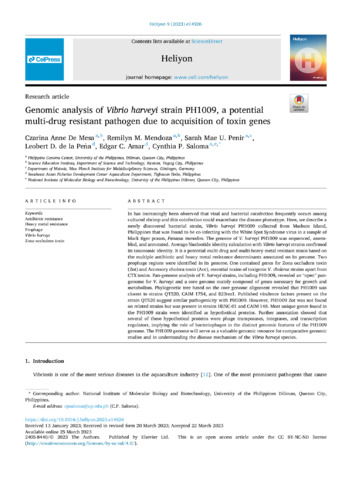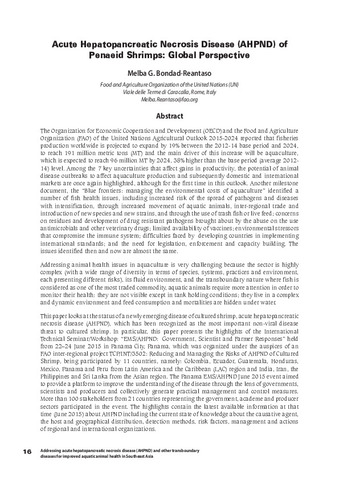Genomic analysis of Vibrio harveyi strain PH1009, a potential multi-drug resistant pathogen due to acquisition of toxin genes
- Global styles
- MLA
- Vancouver
- Elsevier - Harvard
- APA
- Help

Download URL
www.cell.comDate
2023-03-25Author
Page views
780AGROVOC keyword
Taxonomic term
Geographic names
Metadata
Show full item record
Share
Abstract
In has increasingly been observed that viral and bacterial coinfection frequently occurs among cultured shrimp and this coinfection could exacerbate the disease phenotype. Here, we describe a newly discovered bacterial strain, Vibrio harveyi PH1009 collected from Masbate Island, Philippines that was found to be co-infecting with the White Spot Syndrome virus a sample of black tiger prawn, Penaeus monodon. The genome of V. harveyi PH1009 was sequenced, assembled, and annotated. Average Nucleotide identity calculation with Vibrio harveyi strains confirmed its taxonomic identity. It is a potential multi-drug and multi-heavy metal resistant strain based on the multiple antibiotic and heavy metal resistance determinants annotated on its genome. Two prophage regions were identified in its genome. One contained genes for Zona occludens toxin (Zot) and Accessory cholera toxin (Ace), essential toxins of toxigenic V. cholerae strains apart from CTX toxins. Pan-genome analysis of V. harveyi strains, including PH1009, revealed an “open” pan-genome for V. harveyi and a core genome mainly composed of genes necessary for growth and metabolism. Phylogenetic tree based on the core genome alignment revealed that PH1009 was closest to strains QT520, CAIM 1754, and 823tez1. Published virulence factors present on the strain QT520 suggest similar pathogenicity with PH1009. However, PH1009 Zot was not found on related strains but was present in strains HENC-01 and CAIM 148. Most unique genes found in the PH1009 strain were identified as hypothetical proteins. Further annotation showed that several of these hypothetical proteins were phage transposases, integrases, and transcription regulators, implying the role of bacteriophages in the distinct genomic features of the PH1009 genome. The PH1009 genome will serve as a valuable genomic resource for comparative genomic studies and in understanding the disease mechanism of the Vibrio harveyi species.
Description
The following is the Supplementary data to this article: Download .xls (8.95 MB)
Suggested Citation
De Mesa, C. A., Mendoza, R., Penir, S. M., dela Pena, L. D., Amar, E., & Saloma, C. (2023). Genomic analysis of Vibrio harveyi strain PH1009, a potential multi-drug resistant pathogen due to acquisition of toxin genes. Heliyon , 9(4), e14926. https://doi.org/10.1016/j.heliyon.2023.e14926
Type
ArticleISSN
2405-8440Collections
- Journal Articles [1258]
Related items
Showing items related by title, author, creator and subject.
-
Emergency response to emerging diseases: TiLV in tilapia
Senapin, Saengchan (Aquaculture Department, Southeast Asian Fisheries Development Center, 2019)Tilapia lake virus (TiLV) is a novel RNA virus resembling Orthomyxovirus. It has been recently re-classified to Tilapia tilapinevirus species, under Tilapinevirus genus, Amnoonviridae family (ICTV, 2018). Since the first ... -
Acute hepatopancreatic necrosis disease (AHPND) of penaeid shrimps: Global perspective
Bondad-Reantaso, Melba G. (Aquaculture Department, Southeast Asian Fisheries Development Center, 2016)The Organization for Economic Cooperation and Development (OECD) and the Food and Agriculture Organization (FAO) of the United Nations Agricultural Outlook 2015-2024 reported that fisheries production worldwide is projected ... -
Growth, plasma cortisol, liver and kidney histology, and resistance to vibriosis in brown-marbled grouper, Epinephelus fuscoguttatus fed onion and ginger
The health-promoting effects of dietary onion and ginger were studied in brown marbled grouper, Epinephelus fuscoguttatus. An eight-week feeding trial was conducted to evaluate the effects of dietary onion and ginger on ...







